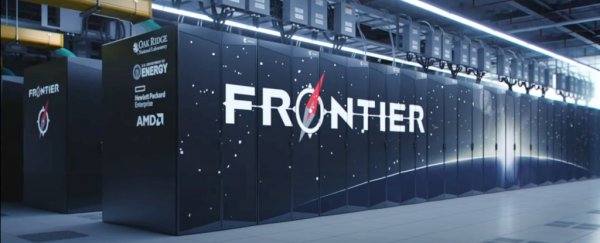The US has succeeded in developing the world's first 'true' exascale supercomputer, honoring a pledge made by President Obama almost seven years ago, and ushering the world into a new era of computational capability.
Until now, the most speedy supercomputers in the world were still working in the petascale, achieving a quadrillion calculations per second. The exascale brings this to a whole new level, reaching a quintillion operations per second.
The Frontier supercomputer, built at the Department of Energy's Oak Ridge National Laboratory in Tennessee, has now become the world's first known supercomputer to demonstrate a processor speed of 1.1 exaFLOPS (1.1 quintillion floating point operations per second, or FLOPS).
The result was confirmed in a benchmarking test called High-Performance Linpack (HPL). As impressive as that sounds, the ultimate limits of Frontier are even more staggering, with the supercomputer theoretically capable of a peak performance of 2 quintillion calculations per second, the Oak Ridge lab says.
All theory aside though, it's the standardized HPL benchmark that matters foremost at TOP500, a twice-yearly ranking of the world's most powerful supercomputers; Frontier's debut score means it's now ranked as the world's fastest system in this elite field of machines.
"With an exact HPL score of 1.102 exaFLOPS, Frontier is not only the most powerful supercomputer to ever exist – it's also the first true exascale machine," TOP500's announcement of the new rankings explains.
Technically, the exascale barrier was first broken in 2020 by the distributed computing project Folding@home that works on various medical problems. But Frontier is the first true exascale machine because the calculations were not spread across numerous home computers, like Folding@home is.

Computer scientists have been building towards the exascale milestone for years now, with the threshold representing a new level of computational power for calculating solutions to very complex problems involving vast amounts of data, such as modeling climate systems, devising new kinds of materials and medicines, and peering into the deepest riddles of physics.
Progress in the field has been almost as speedy as the supercomputers themselves. For the last two years, the number one machine has been the Japanese supercomputer Fugaku, which in 2020 scored 415.5 quadrillion FLOPS (415.5 petaFLOPS).
At the time, that was almost three times better than the machine it ousted from the number one spot, the IBM-built Summit supercomputer, which also resides at Oak Ridge National Laboratory.
In 2022's new rankings, Summit has been relegated to fourth position on the TOP500 list (with a new score of 148.8 petaFLOPS), far behind the performance of Frontier, Fugaku (in second spot at 442 petaFLOPS), and newcomer LUMI from Finland, which scored 151.9 petaFLOPS.
Among all these massively powerful supercomputers, only Frontier has achieved true exascale performance, at least where it counts, according to TOP500.
"Considering the fact that Fugaku's theoretical peak is above the 1 exaFLOP barrier, there's cause to also call this system an exascale machine as well," TOP500's announcement reads.
"However, Frontier is the only system able to demonstrate this on the HPL benchmark test."
There is, some have pointed out, an elephant in the room: the absence of new Chinese supercomputers from the TOP500 list, which were not officially submitted for consideration in the contest.
This means we don't know for sure how they might compare to this year's ranked systems, although Chinese supercomputers have certainly fared well in previous years' rankings, and some commentators believe China may have several imminent exascale systems in the pipeline.
None of which takes away from Frontier's giant accomplishment. For now, this incredible machine ranks as the most advanced computer on the planet – a US$600 million powerhouse poised to tell us many wondrous and important things.
"Frontier is ushering in a new era of exascale computing to solve the world's biggest scientific challenges," says ORNL director Thomas Zacharia.
"This milestone offers just a preview of Frontier's unmatched capability as a tool for scientific discovery."
You can read more about Frontier here, and find TOP500's rankings for June 2022 here.
